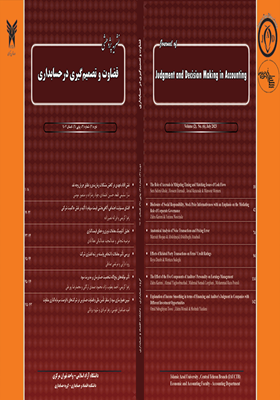نقش اقلام تعهدی در کاهش مشکلات زمانبندی و تطابق جریان وجه نقد
محورهای موضوعی : حسابداری و مالی
سارا سلیمی
1
,
حسین اعتمادی
2
*
![]() ,
جواد رضازاده
3
,
منصور مومنی
4
,
جواد رضازاده
3
,
منصور مومنی
4
1 - گروه حسابداری، دانشگاه تربیت مدرس، تهران، ایران
2 - گروه حسابداری، دانشگاه تربیت مدرس، تهران، ایران
3 - گروه حسابداری دانشگاه تربیت مدرس،تهران ،ایران
4 - گروه حسابداری ، دانشگاه تهران،تهران ، ایران
کلید واژه: واژههای کلیدی: اقلام تعهدی, جریان وجه نقد, همبستگی سریالی منفی,
چکیده مقاله :
چکیدهحسابداری تعهدی، با استفاده از اقلام تعهدی، سعی در رفع مشکلات زمان بندی و تطابق جریان وجه نقد دارد. هدف این مطالعه بررسی این موضوع است که اقلام تعهدی گزارش شده توسط شرکت های پذیرفته شده در بورس اوراق بهادار تهران تا چه میزان برای رسیدن به هدف غایی آن ها در کاهش مشکلات زمان بندی و تطابق جریان وجه نقد مورد استفاده قرار می گیرند. برای این منظور، داده های ترکیبی 153 شرکت پذیرفته شده در بورس اوراق بهادار تهران با استفاده از تحلیل رگرسیون چند متغیره مورد بررسی و تجزیه و تحلیل قرار گرفت.یافته ها حاکی از آن است که در شرکت های مورد بررسی، رابطه بین اقلام تعهدی و تغییرات جریان وجه نقد منفی می باشد و شدت این رابطه با افزایش مشکلات جریان وجه نقد افزایش می یابد. نتایج بدست آمده نشان می دهد که اقلام تعهدی برای کاهش نوسانات جریان وجه نقد، که به عملکرد دوره جاری مربوط نیستند، مورد استفاده قرار می گیرند. همچنین هر چه مشکلات زمانبندی و تطابق جریان وجه نقد بیشتر باشد، اقلام تعهدی به طور فزاینده ای برای رفع این مشکلات مورد استفاده قرار میگیرند. بنابراین استفاده از کارکرد اقلام تعهدی در کاهش مشکلات زمان بندی و تطابق جریان وجه نقد، برای توضیح این اقلام مناسب به نظر می رسد.
AbstractOne purpose of accrual accounting is to mitigate the timing and matching problems inherent in cash flows. Cash flows have timing and matching properties that impair their ability to measure performance. Net cash receipts and payments can occur in periods that differ from the economic event (the timing or spreading problem), and cash inflows and outflows from a given economic event might occur in different periods (the matching problem). The economic role of accruals is to mitigate these timing and matching issues. These problems cause temporary fluctuations in cash flows. Accruals smooth temporary timing fluctuations in operating cash flows and thus it is expected to find a negative correlation between accruals and changes in cash flows. It is also expected that the negative correlation between accruals and cash-flow changes grows as cash flow problems intensify because accruals will increasingly counteract cash flow changes as a firm’s cash flows increasingly stray from desired properties. According to Dechow et al. (1998), the negative serial correlation in cash flow changes shows the cash flow timing and matching problem. The timing and matching problems of cash flows counteract each other. The timing problem leads to a positive serial correlation in cash flow changes. While the matching problem leads to a negative serial correlation in cash flow changes. According to Dechow et al. (1998) model, the serial correlation in cash flow changes is a function of operating cash cycle and profit margin and the magnitude of negative serial correlation in cash flow changes depends on the relative magnitude of the operating cash cycle and the profit margin. The longer the operating cash cycle and the smaller the profit margin, the negative serial correlation in cash flow changes is more severe. So it is expected that the negative correlation between accruals and cash-flow changes grow as the negative serial correlation in cash flow changes is severe (longer operating cash cycle and smaller profit margin). This study investigates the extent to which accruals are reconciled whit their ultimate purpose in mitigating timing and matching problems inherent in cash flows. A sample of 153 firms listed in the Tehran Stock Exchange (TSE),,is analyzed using panel data regression models. we observed that there is a negative correlation between accruals and cash-flow changes and this negative correlation increases as the timing and matching problems of cash flows become more severe. The results of this study show that accruals are used to mitigate timing and matching problems of cash flow and firms listed in the Tehran Stock Exchange use accruals more when there are more problems with cash flows.
فهرست منابع
ولیان، ح.، و عبدلی، م.، و استادهاشمی، ع.، و طهماسبی زاده، ر. (1398)، "بررسی تأثیر ثبات مدیریتی بر مدیریت سود شرکتهای پذیرفته شده در بورس اوراق بهادار تهران"، فصلنامه پژوهشهای تجربی حسابداری، 9(1)، صص 245-275
_||_

